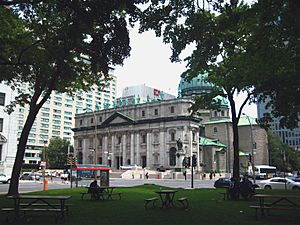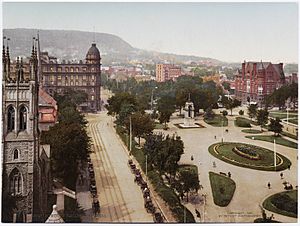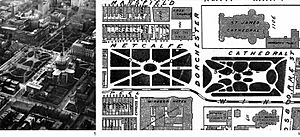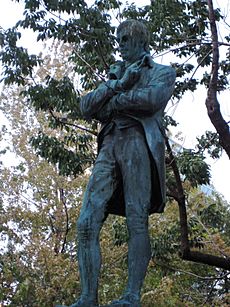Dorchester Square facts for kids
Quick facts for kids Dorchester SquareFrench: Square Dorchester |
|
|---|---|
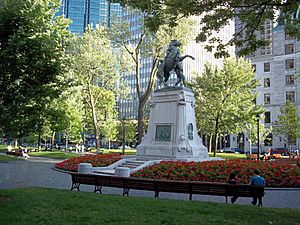 |
|
| Lua error in Module:Location_map at line 420: attempt to index field 'wikibase' (a nil value). | |
| Type | Town square |
| Location | Downtown Montreal, Ville-Marie Montreal, Quebec, Canada |
| Area | 2.1 hectares (5.19 acres) |
| Created | 1876 |
| Operated by | City of Montreal |
| Status | Open all year |
Dorchester Square (also known as Square Dorchester in French) is a big park in downtown Montreal, Canada. It used to be called Dominion Square. This green space, along with Place du Canada, covers a large area. It's a popular spot for people walking around the city. The square is open 24 hours a day.
The city started buying land for the square in 1872. It officially opened in 1878, but wasn't fully finished until 1892. There are four statues in the square. They were first placed to look like a Union Jack flag.
In 2010, the square got a big makeover that cost $14 million. They removed an old flower stand and fixed up all the statues. New benches and lights were added. The new lights make the square look amazing at night. Small crosses were put into the walkways as a reminder that the area was once a cemetery.
Contents
History of Dorchester Square
Before 1854, this area was mostly an open green space. It was also used as a cemetery called Sainte-Antoine. This cemetery was for people who died during the cholera outbreak in 1851. In 1854, the bodies were moved to Notre-Dame-des-Neiges Cemetery.
In 1869, St. George's Anglican Church was built nearby. This led to more churches being built around the square. The area started to become a dividing line between fancy homes and shopping areas. In the 1870s, big projects made the square a central meeting place. The park took its current shape in 1878.
At the same time, the Catholic Church started building Mary, Queen of the World Cathedral across from the square. The Windsor Hotel was also finished by 1878. With these important buildings, the square became a key part of the city. It was a busy spot for people moving between offices, shops, and homes.
In 1889, the Canadian Pacific Railway built Windsor Station near the square. This made the square even more important. Later, the original YMCA building was taken down. This made way for the Sun Life Building, which now covers the entire eastern side of the square. In 1929, the Dominion Square Building was built on the north side. It had shops and offices.
After World War II, more buildings were added. The Laurentian Hotel was built, and part of the Windsor Hotel was removed for the CIBC Tower. In the 1960s, Dominion Square became a central point for new, tall skyscrapers. A skywalk was built to connect it to Place du Canada and the Château Champlain hotel.
In 1967, Dominion Square was split into two parts. The southern part was renamed Place du Canada. The northern part kept the name Dominion Square for a while.
After a politician named René Lévesque died in 1987, Dorchester Boulevard was renamed after him. Dominion Square was then renamed "Dorchester Square." This new name honored Guy Carleton, 1st Baron Dorchester, who supported French-speaking people in Canada.
Monuments in Dorchester Square
There are four main statues in Dorchester Square. They were first set up in a cross shape. The square's statues and name show the business spirit of Montreal's English-speaking community from the Victorian era.
Tribute to Sir Wilfrid Laurier

The first statue you see from the south side is a tribute to Wilfrid Laurier. It was built in 1953. Laurier was Canada's first French-Canadian prime minister. His statue faces south towards the United States. He wanted Canada to have closer economic ties with the U.S.
His statue also faces the tribute to John A. Macdonald in Place du Canada. Macdonald was Canada's first prime minister. Laurier's statue is surrounded by trees. It has carvings that show the provinces united under his leadership.
Boer War Memorial
The Boer War Memorial faces north. It is the only statue in Montreal that shows a person on a horse. The Boer War was not popular in Quebec. Many people saw it as an imperial war. Prime Minister Wilfrid Laurier was against the war.
The war caused many losses, especially among middle and upper-class men. Around the base of the statue, you can see carvings and the names of battles. This memorial is in the center of the square.
Lion of Belfort
The Lion of Belfort is a fountain in the square. It was originally part of the cross shape of the monuments.
Robert Burns statue
The Robert Burns statue is on the western side of the square. It faces west. This statue honors the Scottish poet Robert Burns. It also pays tribute to the Scottish business people in Montreal. Burns represents the refined and socially aware ideals of the Scottish community.
How the Square is Used in the City
Dorchester Square and Place du Canada are very important for downtown Montreal. They help people move around the city and change how they travel.
Getting Around and Changing Transport
These squares act like a central hub for transportation. You can reach them from Montreal's two main train stations: Windsor Station and Central Station. Four metro stations are also nearby. The squares are connected to three busy parts of Montreal's Underground City, Montreal.
The area is also close to major highways. This helps car traffic spread out. Soon, a direct train link to Pierre Elliott Trudeau International Airport will bring airport travelers right into this hub.
The squares make it easy to switch between different ways of traveling. There are many parking spots downtown focused around the square. From the square, you can easily get to public transport. To the east, the Place Ville Marie corridor of the Underground City takes people from McGill University all the way to Place Bonaventure.
From Place Bonaventure, you can go further east to Square Victoria and Old Montreal. To the west, you can connect to Windsor Station and the Bell Centre.
Connecting to the Underground City
Pedestrian traffic from the north and northwest can reach areas like McGill College Avenue. This includes shopping malls like the Montreal Eaton Centre and Place Montreal Trust. So, from the north side of the square, you can get to both Peel and McGill metro stations.
However, some important buildings are not connected to the Underground City. The Sun Life Building's main vault is underground. This means people have to go outside to cross the square to reach it. The same is true for buildings like the CIBC Tower and the Dominion Square Building. This encourages people to walk through the square itself.
Social Gatherings
Because some buildings are not connected underground, many people walk through the square. This makes it a lively place, especially in good weather. People from all parts of the city use it. The square is open to the public at all times.
In summer, tourists and office workers mix with students and artists. There's a snack bar and café at the north end of the square. It's called a Camillienne, named after a former Montreal mayor. The northwestern part of the square has many restaurants and bars. Thousands of people fill the square at lunchtime. They enjoy the sunshine and shade.
The square is also a great place for protests and rallies. It's big enough for many people. It's very visible, so messages are easily seen by office workers looking down from windows. Police can also observe from a distance.
Protests in Montreal are usually peaceful. For example, a small weekly protest happens at the southwest corner of Dorchester Square. It's against actions by the Government of Israel, whose Consulate General is across the street.
Unity Rally
One of the most famous events here was the Unity Rally on October 27, 1995. This was three days before the 1995 Quebec referendum. People from all over Canada came to Dorchester Square and Place du Canada. They joined a huge demonstration to support Canada staying united. Estimates for the crowd size ranged from 35,000 to 150,000 people.
Many important leaders were there, including Prime Minister Jean Chrétien. Even though some people who wanted Quebec to separate were there, the event was peaceful. The Montreal Police made sure everyone followed the rules. This meant that arguments stayed as passionate debates.
Current Renovation Plan
A landscape architect named Claude Cormier is leading a renovation project. It will cost $3.5 million over four years (2009–2012). The goal is to make the square look fresh and new. There won't be big changes to its overall design. Instead, it will get a "facelift" and a new lighting system. This system will light up all the statues and monuments.
Images for kids
-
ANZAC Day in 1941


